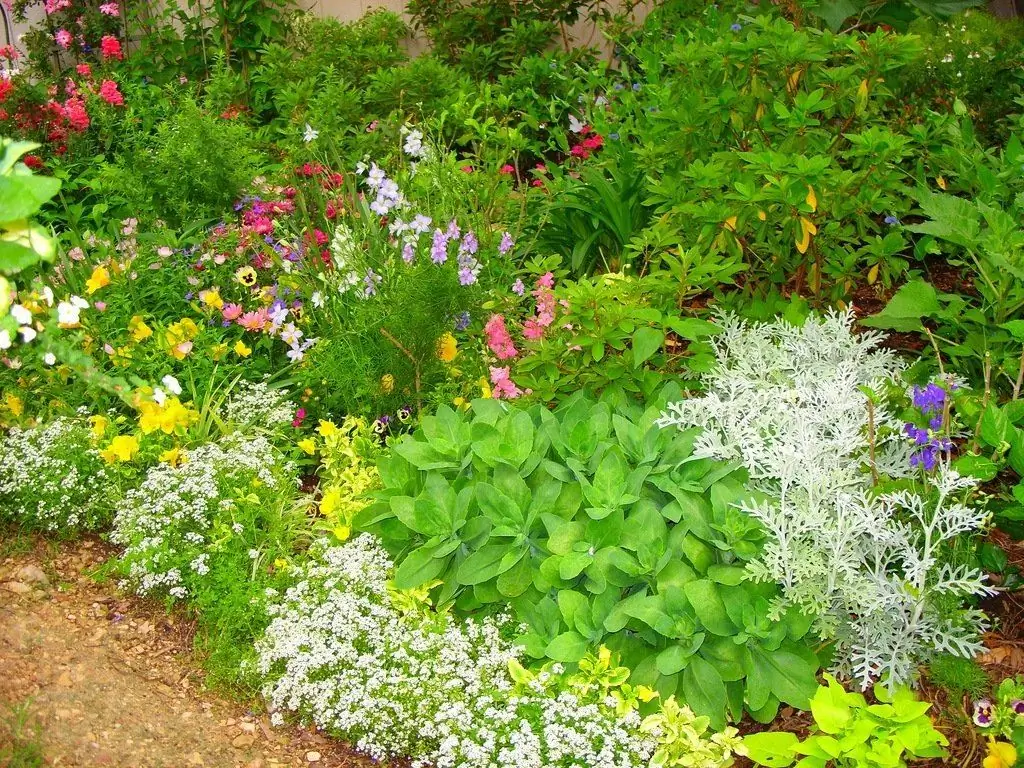
Table of contents:
- Author Bailey Albertson [email protected].
- Public 2023-12-17 12:53.
- Last modified 2025-01-23 12:41.
DIY landscape design: how to make a mixborder

Many gardeners and owners of summer cottages dream of transforming their country estate, making it original and unusual. If you love flowers, then a DIY mixborder is what you need! A properly designed and well-maintained mixborder will decorate any site, both large and small.
Mixborder features
Mixborder is a mixed type flower garden with an elongated shape. It can include various plants, both annuals and perennials. The mixborder can also include shrubs, small vines and trees.
Such a flower garden can be very difficult to maintain, because each type of plant has its own needs. In addition, it is not easy to weed: all plantings are located tightly to each other
But, nevertheless, the mixborder is considered one of the most effective types of flower beds. It looks picturesque due to the abundance of plants and flowers of different sizes and colors, height and flowering period. Mixborder will delight you from early spring to late autumn, if you choose the right plants for it.

Arrange flowers for mixbroder in tiers, in height
For a natural look of a flower garden, soft and free lines should be selected for it. The planting scheme is as follows: tall plants need to be planted in the background, and in front of them are medium-sized and low ones. If you plan to position the mixborder so that it is visible from different points of the garden, then tall plants are planted in the center and framed by undersized ones. Sometimes it is permissible to plant a couple of tall plants in the foreground.
Before you start choosing and planting plants for a future mixborder, you need to choose the most successful location for it.
Choosing a place and plants: the best option
First of all, you need to draw up a detailed explication. In this case, you need to consider:
- area illumination;
- soil composition;
- humidity;
- windproof.
Each of these parameters separately and all of them together will affect how your mixborder will look.
Plants that are not prone to rapid growth and aggressive soil capture are excellent for such a flower garden. When buying flowers, check with sellers about their root system. Creeping rhizomes or roots that grow rapidly in width are categorically unsuitable: they will compete with each other. The strongest will survive the fight, but the composition will be completely destroyed.

Large-leaved plants will complement the mixborder well
When creating a mixborder, certain rules should be observed, in particular, the principle of grouping floristry.
- A common technique is to create a mixborder background: evergreen low-growing coniferous perennials are planted as a landscape frame. Mountain pine, barberry, weigela, juniper or cinquefoil are best suited for this.
- Grouping plants by size allows you to create a spectacular flower bed or border. Tall flowers should be placed in the background, low flowers in the foreground. Leave gaps between the different groups to weed out the flowers.
- You can choose the color palette to your liking, but observe the rule: the tones of neighboring groups should not overlap each other. It is better if they smoothly flow from one to another. White is recognized as a universal color: it can be placed anywhere. An interesting solution is to arrange contrasting shades on opposite sides.
- The best option would be to use a scheme in which the voids between not densely located perennials are filled with annuals.
Variety of mixborder styles
Mixborder style directly depends on which landscape design concept you choose.
The landscape style is the most common. It came to us from England, where it is used most often. Such a mixborder will be well complemented with coniferous shrubs, varietal plants, as well as a border of wild flowers, such as:
- nivyanik;
- bells;
- poppy;
- chamomile.

An example of a mixborder in a landscape style
Large-flowered plants are more characteristic of the country style. Use cosmea, nasturtium, dahlias, peonies, roses, lupines, phlox and petunias for such a flower garden. Stock rose and sunflowers will look great against a backdrop of vibrant flowers.

Country style
Vegetable mix broders are very popular. If you compose them correctly, then they will become not only an original decoration of your summer cottage, but also bring a harvest at the end of the season. For such a flower garden, decorative vegetables are used (ornamental and curly beans, dwarf peppers), ordinary vegetables - cabbage, tomatoes, carrots), as well as spicy herbs of different colors and shapes. For example, green and purple basil, simple and curly parsley, various salads.

Vegetable mixborder
The main rule in creating a mixborder is the correct calculation of the timing of flowering. Periods should smoothly replace each other so that the composition remains in bloom throughout the season - from spring to autumn
The main stages of arranging a flower garden
Let's consider step by step the creation of the most common and simple type of mixborder.
Step one: we plant “skeletal plants. These perennial shrubs will set the height of the curb and fill it. They need to be planted at a small equidistant distance from each other, leaving free space. This gives the composition a more natural look.
In addition to coniferous perennials, a good addition will be:
- hibiscus;
- jasmine;
- magnolia;
- hydrangea;
- elder;
- red-leaved plum;
- the dogwood is white.
Please note that these tree crops grow over time, so they should not be planted close to each other. Prune shrubs in time to prolong their flowering.

Layout of plants in a mixborder
The second step is to fill the flower garden with perennials. Here you need to follow the principle of tiered. In the foreground, stunted perennials are placed to close the elongated stems of shrubs.
In order to dilute the composition, use decorative leafy crops. Against the background of variegated flowers, leaves of wormwood and cineraria will look very beautiful. The decorative foliage of the majestic geranium or the burgundy leaves of tunbergia and heuchera will act as a contrasting background to the bright colors. Among medium-sized perennial grasses, the most decorative are feather grass, pearl-barley, sedge, meadow-grass, hare-tail, ochik.
The third step: summer and bulbous as the final touch. Plant variegated annuals between perennial plants to add elegance to the composition. In spring, the mixborder will wake up with primroses: snowdrops, crocuses, forest trees. They will be followed by tulips, daffodils, primroses, annuals, and then autumn flowering plants. Plant annuals in small groups as well. Avoid planting aggressive species prone to rapid growth of green mass and displacement of neighboring plants.
Video about creating a mixborder
Each of us is up to the task of creating such beauty in our summer cottage, you just need to make an effort and be patient. We hope that our tips will help you create a great DIY mixborder to enjoy its beauty throughout the summer season. Share your ideas in the comments. Good luck and easy work!
Recommended:
Methods And Schemes For Planting Potatoes, How And At What Depth To Plant

Interesting and productive ways of planting potatoes. The most common landing patterns. Important nuances when growing
We Decorate The House For The New Year With Our Own Hands: A Selection Of Ideas And Photos Of Decor

How to decorate a house for the New Year. DIY garlands, compositions, snowflakes and toys for the Christmas tree. Decorations for windows. New Year's table setting. Photo galleries
Italian Cuisine In A Classic Style: Examples Of Interior Design, Wall And Floor Decoration, Furniture, Accessories, Classics Of Italy, Photo Ideas

The main features of the classic Italian style and its use in kitchen decoration. How to choose materials and decor for the kitchen and what to consider finishing
Do-it-yourself Flowerbeds Of Tires And Tires: Step-by-step Instructions, A Selection Of Ideas, Master Classes, Photos And Videos

What is the advantage of tire beds. How to prepare the material and cut the tire. Garden decoration options with tire and tire beds. Master Class
What Can Be Done From Old Tights: Nylon, Cotton, Children's, Photos And Videos, A Selection Of Ideas

How to use old tights (nylon, cotton, woolen) for home, garden, handicrafts and hobbies: ideas, advice, instructions. Photo. Video
